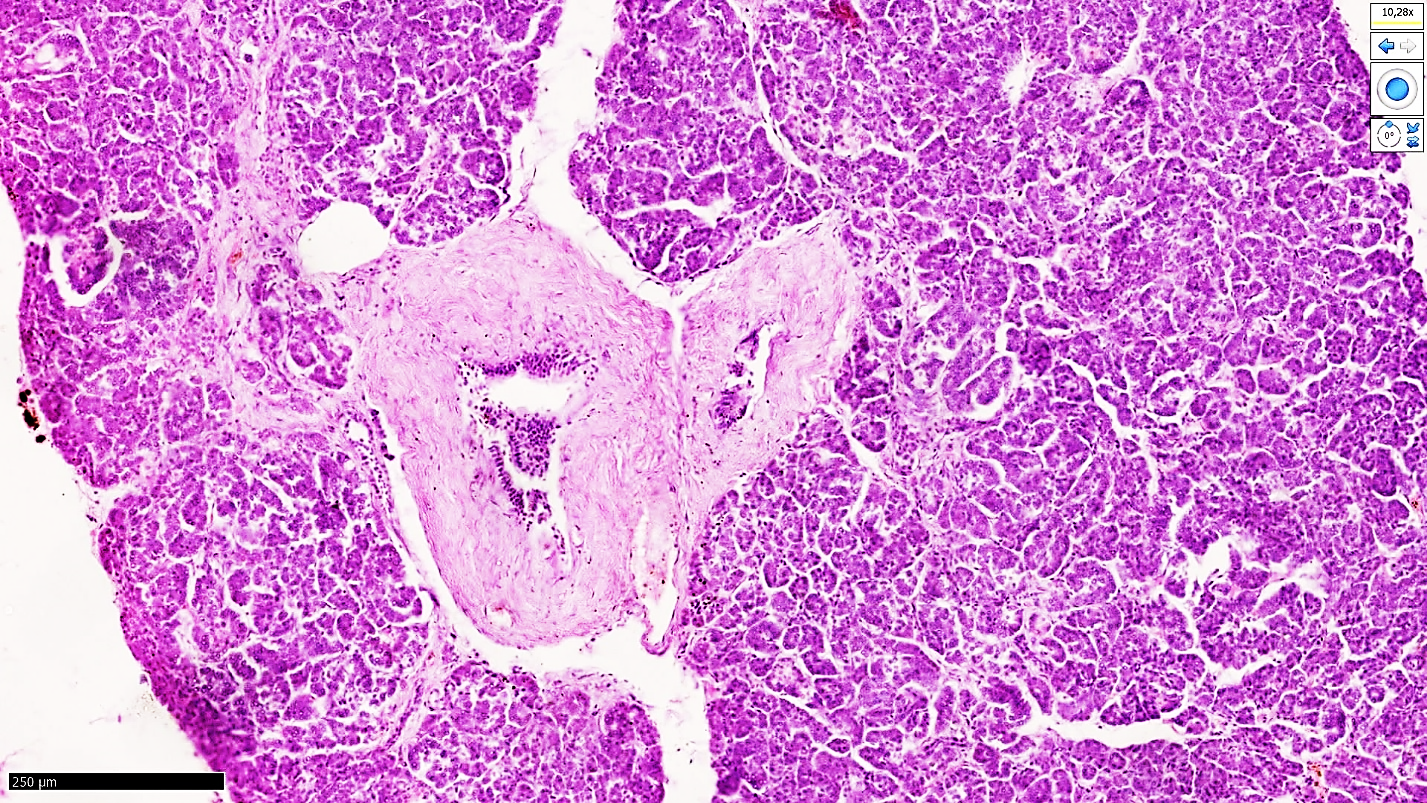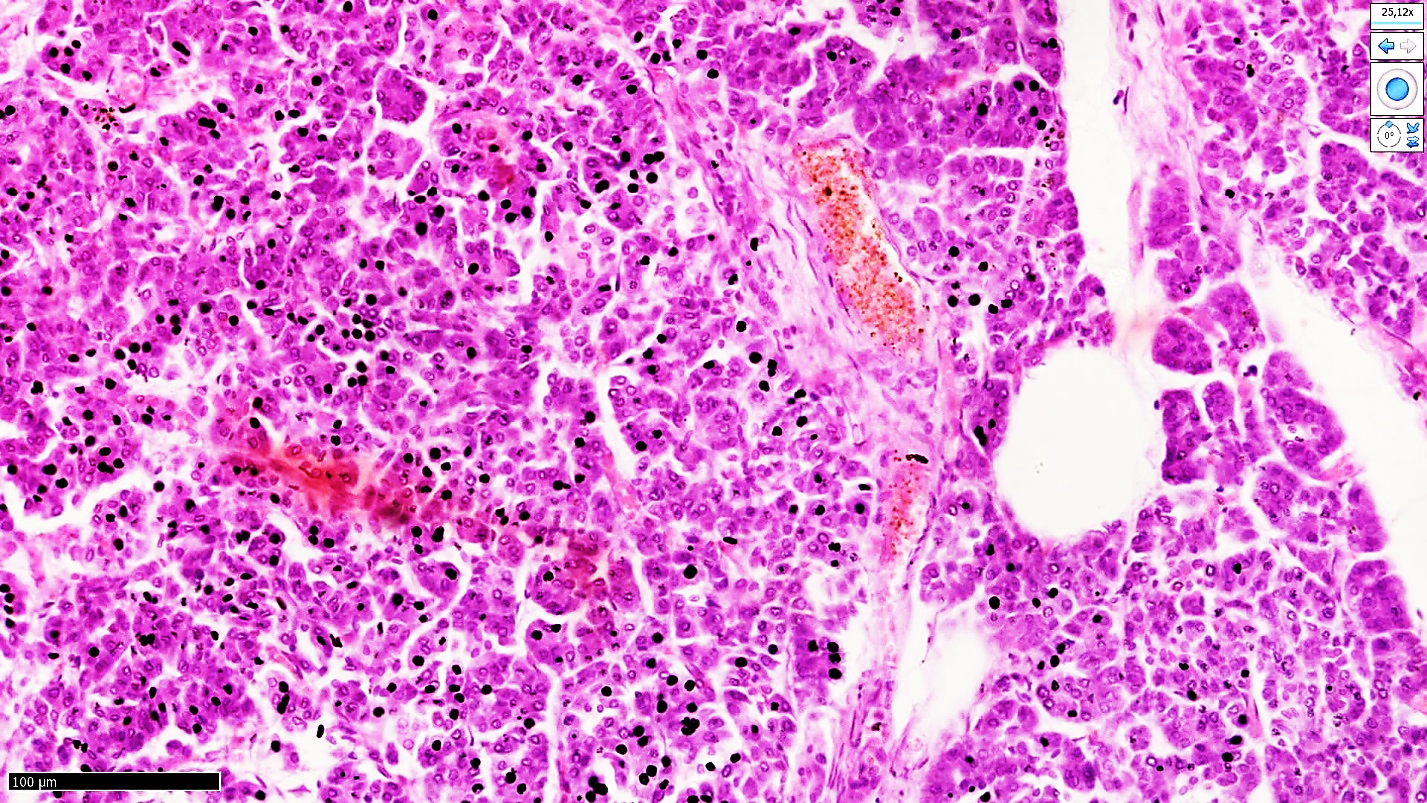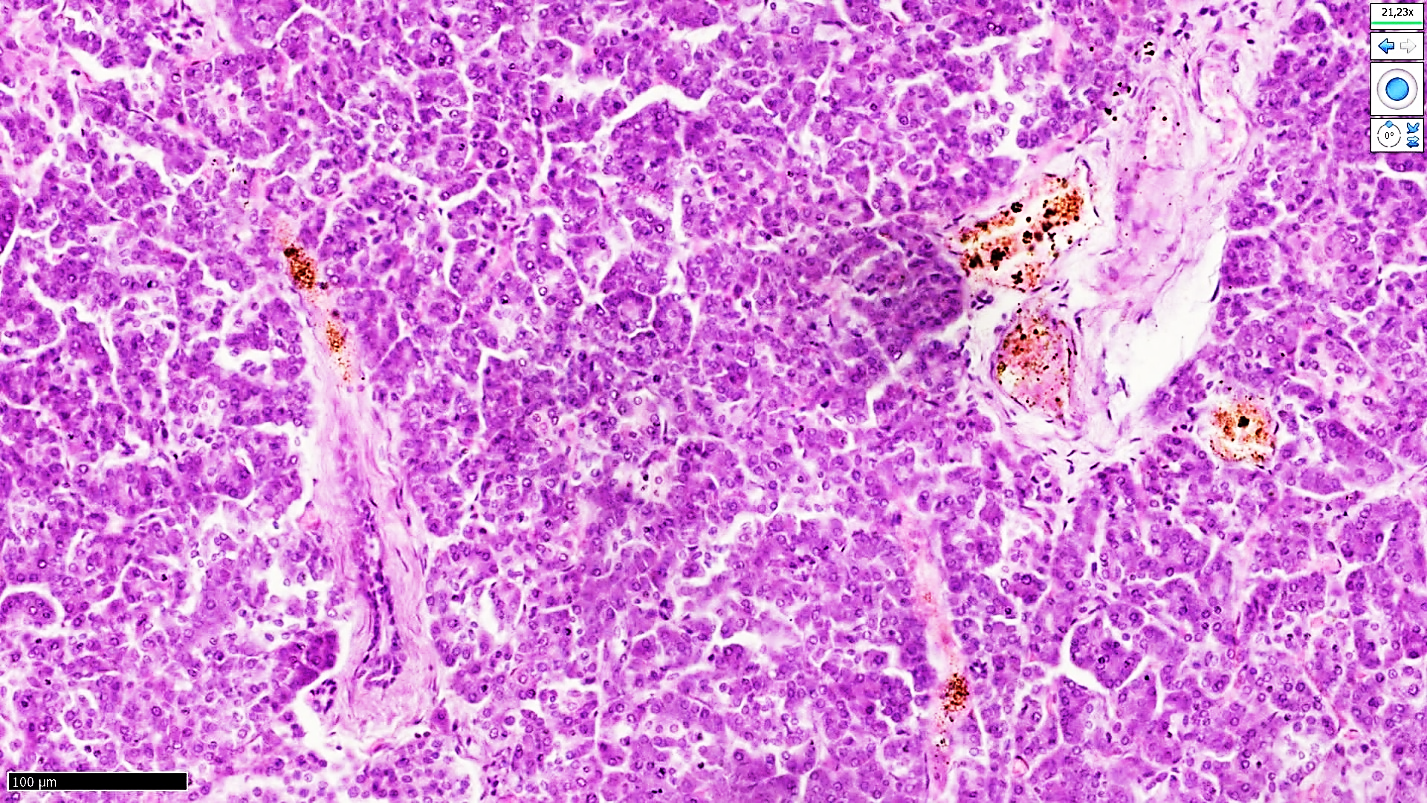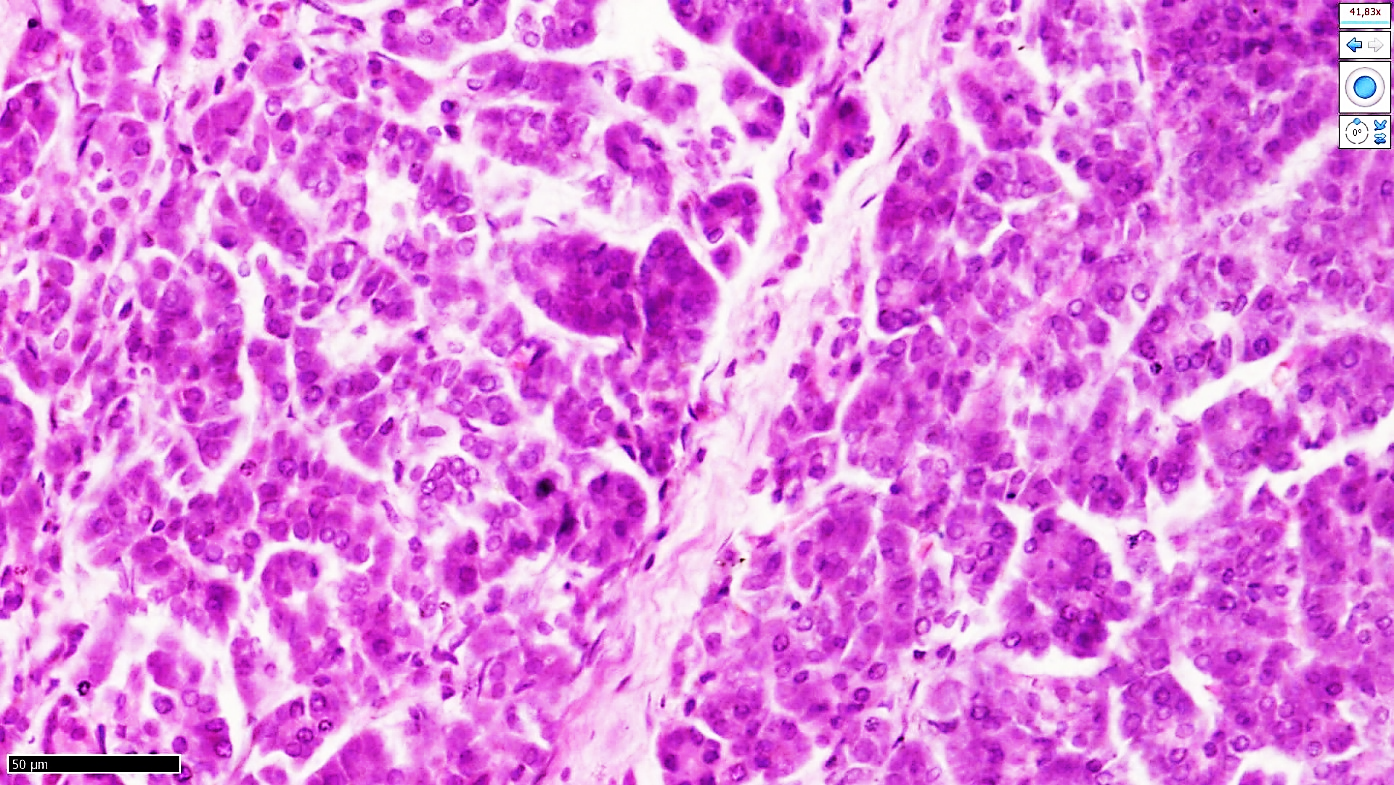Sharipova Barno Ergashevna, Tursunov Khasan Ziyaevich
Assistant Lecturer, Department of Pathological Anatomy of the Tashkent Medical Academy, Uzbekistan
Copyright © 2024 The Author(s). Published by Scientific & Academic Publishing.
This work is licensed under the Creative Commons Attribution International License (CC BY).
http://creativecommons.org/licenses/by/4.0/

Abstract
The peculiarity of the changes in the histioarchitectonics of the pancreas in covid-19 infection is that in covid-19 there is a sharp increase in the permeability of the vessel wall, the occurrence of interstitial edema and the blurring of all components in the gland tissue, the shape of the cells changes as a result of interstitial edema, the glands are compressed into a circle, the islets of Langerhans oval-shaped and dumbbell-shaped, at the same time, homogeneous tumors appeared around the gland ducts and blood vessels, and the sudden development of intermediate tumors in this area and the retention of gland secretions in the synthesized areas, i.e., in the acinar gland cavity, passing into the appearance of dampness, and in the general background, this picture is hypercellular. was found to have arrived.
Keywords:
Pancreas, Covid-19, Necrobiosis, Pathomorphology, Pancreatitis
Cite this paper: Sharipova Barno Ergashevna, Tursunov Khasan Ziyaevich, Changes in the Histioarchitectonics of the Pancreas Associated with COVID-19 Infection, American Journal of Medicine and Medical Sciences, Vol. 14 No. 11, 2024, pp. 2689-2692. doi: 10.5923/j.ajmms.20241411.01.
1. Introduction
During the covid-19 pandemic, diabetes was ignored in patients, and while the main diagnosis and treatment were focused on covid-19 infection, according to the autopsy data, it was found that hemorrhagic pancreatitis developed in many internal organs, including the pancreas [1]. According to thanotogenesis, acute hemorrhagic inflammation of the pancreas directly causes the patient's death, this information was not taken into account in lekuin covid-19. As a result, the detection of acute hemorrhagic pancreatitis during the autopsy confirmed the relevance of the problem once again. This situation in the covid-19 pandemic in the USA and European countries caused a lot of data to be lost in the period of time without autopsies of the deceased [2]. The same database was investigated after Spanish pathologists reported in a September 2020 report on the controversial autopsy data. In 23.6% of those who died from covid-19, the specificity of the pathomorphological changes of the pancreas was revealed: massive venous engorgement, acinar glands being located in a dense complex with each other, forming an edematous appearance, and massive diapedesis hemorrhages in the periacinar veins [3,4]. In this regard, the data base was not analyzed, and in the case of peragonia, parenchymatous organs were evaluated as the appearance of venous fullness. However, hyperglycemia, high level of SRB-protein, and sharp increase of AAB-protein in blood plasma were ignored in the laboratory parameters. In this research work, we have set ourselves the goal of studying specific morphological changes of the pancreas during the exudation stage of covid-19 infection and making scientific and practical recommendations based on the analysis of the obtained data.Purpose: to study specific and general morphological changes in the pancreas during covid-19 infection and to come to clear conclusions about the outcome of the obtained results.
2. Material and Methods
Pancreatic tissue material extracted at autopsy from a total of 116 cases of covid-19 death at the Center of Pathological Anatomy of the Republic was prepared and hematoxylin and eosin dye was used to examine the morphological changes in the pancreas.
3. Research Results and Their Discussion
The capsule of the pancreas is of different thickness, signs of fullness in the blood vessels, focal diapedesis hemorrhages around it were detected. At the same time, an edematous manza, containing lymphocytes and a small amount of neutrophils, is detected under the capsule. macrophages are rare. Although the standard histioarchitectonics of the acinar glands in the fragments located close to the subcapsular branch has not changed, they have a swollen appearance, and it is determined that dark basophilic structures remain in the cavity of the acinar glands (Fig. 1). | Figure 1. Covid-19 is confirmed. Pancreas in general background. Interstitial swelling around the acinar glands developed (1), the islets of Langerhans were formed, and the cellular content decreased (2). Paint G.E. The size is 10x10 |
The cytoplasm of acinar epithelia of the pancreas is darkly stained, uniform in shape, the nuclei are located basally, and most of them are arranged in the same order, the shape is oblong, and the oblong is bent to one side according to the pole, the field of polar magnetic resistance is strongly expressed in interstitial tumors between the tissues. confirms that the acini of the gland are bent to one side (see Fig. 2).  | Figure 2. Diapedesis blood flow to the pancreas islet of Langerhans and necrobiosis and interstitial edema are detected in chromophilic cells, segmental necrosis in testis and signs of fullness in pericyanar vessels are detected. Paint G.E. The size is 40x10 |
Small-caliber blood vessels located around the gland are characterized by obvious fullness and foci of diapedesis hemorrhage, segmental necrosis of acinar glands and foci infiltrated with macrophages are identified in the branches of most of the vessels. This picture is clearly described in the islets of Langerhans, and as a result of the thickening of the basement membrane of this islet, the developed fullness in the small-caliber blood vessels and the compression of the plasmatic interstitial tissue, it is determined that the chromophilic cells have undergone atrophic and necrobiotic changes. It was this scenario that led to the occurrence of hyperglycemia on the background of diabetes mellitus and the development of hyperglycemic coma in patients with fatal consequences (23 cases in RPAM 2021). It was found that the phenomenon of sludge developed in the small-caliber blood vessels and capillaries in the space of the islets of Langerhans leads to the development of plasmarrhagia in these areas, and interstitial swelling leads to the sliding of the acinar glands outside the islets and the segmental necrosis of the gland epithelia and clastolysis of the gland structure due to compression crushing (see Fig. 2). Destruction of sparse fibrous structures and interstitial edema are detected in the branches of the capsule of the pancreas that have grown around the lobes, these changes are detected around the majority of lobes, indicating that the hemodynamic disorders in covid-19 have developed in the microcirculatory body, and most of the hypoxia process is the development of acid uric acid in the extracellular matrix (Fig. 3).  | Figure 3. Covid-19 confirmed. Minutes No. 53VI. N is 51 years old. Pancreatic acinar gland structures have multifocally developing necrosis foci in the center (1), reliefs of the glands have changed in a wave-like manner, in the form of polarization (2), the islet of Langerhans is slightly deformed (3). Paint G.E. The size is 40x10 |
As a result, it was found that fibroblasts developed sharp proliferation foci in this area and created chaotically formed foci of fibrous structures (see Fig. 3). It is covid-19 that causes massive vascular damage, causes disruptions in the microcirculatory system in the pancreas, increases wall permeability in small-caliber blood vessels around the gland acini, and leads to the development of plasmatic swelling in the surrounding tissues. In particular, the basal membrane of the acinar gland epithelia was damaged, fragmentation of the fibrous structures of the symplast layer of the basal layer and disruption of nutrition of the gland cells, and the field of view at 400x magnification showed the increase of cells undergoing necrobiosis in the gland epithelia (Fig. 4).  | Figure 4. Covid-19 confirmed. Minutes No. 49VI. L is a 53-year-old woman. In segmental pancreonecrosis segments with interstitial sclerosis (1), irregular proliferation of fibroblasts and a chaotic band appearance of fibrous structures (2) |
The sizes of the glands are of different sizes, sudden changes, dystrophic changes of a protein nature in gland epithelia, necrobiosis cells are determined. In the epithelia of the glands, which make up 3/2 of the same gland structures, a clear necrosis process was detected and manifested in the form of segmental pancreonecrosis [5]. Around the segmental pancreonecrosis, macrophages are infiltrated, and a small number of neutrophils are detected. The swelling and destruction of the basal membrane between the blood vessel wall and the natmoic layers increases the permeability, it occurs in the same branches of the pancreas, one of the most characteristic aspects is the fullness of the microcirculatory vessels in covid-19, the sludge phenomenon and plasmatic swelling in the basal layer of capillaries, the presence of vacuolar dystrophies in the cytoplasm of pericytes, perivascular it was determined that intermediate tumors were formed in the branches, that the acinar glands, which are the immediate border of the branches where the intermediate tumors were formed, were oval in shape and underwent many segmental necrosis, and there were many dark eosinophilic inclusions in the ice cavities [6,7]. This is characterized by systemic vascular damage in covid-19 infection, which continues with systemic damage to all small-caliber blood vessels and capillaries.
4. Conclusions
In conclusion, it was found that in covid-19 infection, after entering the causative vessel cavity, massive dilatation and paralytic expansion of all small-caliber blood vessels and capillary walls continued with hyperemias and diapedesis hemorrhages. It is precisely this picture that develops in the same way in all parts of the pancreas, develops in the form of systemic vasculitis of vessels in covid-19, increases the plasma permeability of the basement membrane between the anatomical layers of all blood vessels, and increases the permeability of the vessel wall, including sudden hemodynamic disturbances in the pancreatic microcirculatory body. It was found that the development continued with the development of diabetes and segmental pancreonecrosis, which was first detected from a clinical morphological point of view. This confirms that in the early stages of the mechanism of thanotogenesis in covid-19, acute damage to the pancreas, polyorgan failure develops, making it difficult for the attending physician to focus on the aspects of the treatment, with the tactical help of the patient's death, and the symptomatic treatment is ineffective and the death rate is high.
References
| [1] | Correia de Sá T, Soares C, Rocha M. Acute pancreatitis and COVID-19: A literature review //World J Gastrointest Surg. 2021 Jun 27; 13(6): 574-584. |
| [2] | Jabłońska B, Olakowski M, Mrowiec S. Association between acute pancreatitis and COVID-19 infection: What do we know? // World J Gastrointest Surg. 2021 Jun 27; 13(6): 548-562. |
| [3] | Kusmartseva I, Wu W, Syed F, Van Der Heide V. Expression of SARS-CoV-2 Entry Factors in the Pancreas of Normal Organ Donors and Individuals with COVID-19. // Cell Metab. 2020 Dec 1; 32(6): 1041-1051. |
| [4] | Coate KC, Cha J, Shrestha S, Wang W. et al. SARS-CoV-2 Cell Entry Factors ACE2 and TMPRSS2 Are Expressed in the Microvasculature and Ducts of Human Pancreas but Are Not Enriched in β Cells. // Cell Metab. 2020 Dec 1; 32(6): 1028-1040.e4. |
| [5] | Figueroa-Pizano MD, Campa-Mada AC, Carvajal-Millan E, Martinez-Robinson KG, Chu AR. The underlying mechanisms for severe COVID-19 progression in people with diabetes mellitus: a critical review. // AIMS Public Health. 2021 Oct 26; 8(4): 720-742. |
| [6] | Goyal H, Kopel J, Ristić B, Perisetti A, Anastasiou J, Chandan S, Tharian B, Inamdar S. The pancreas and COVID-19: a clinical conundrum. ||Am J Transl Res. 2021 Oct 15; 13(10): 11004-11013. |
| [7] | Pandanaboyana S, Moir J, Leeds JS, Oppong K, Kanwar A. SARS-CoV-2 infection in acute pancreatitis increases disease severity and 30-day mortality: COVID PAN collaborative study. // Gut. 2021 Jun; 70(6): 1061-1069. |


 Abstract
Abstract Reference
Reference Full-Text PDF
Full-Text PDF Full-text HTML
Full-text HTML


